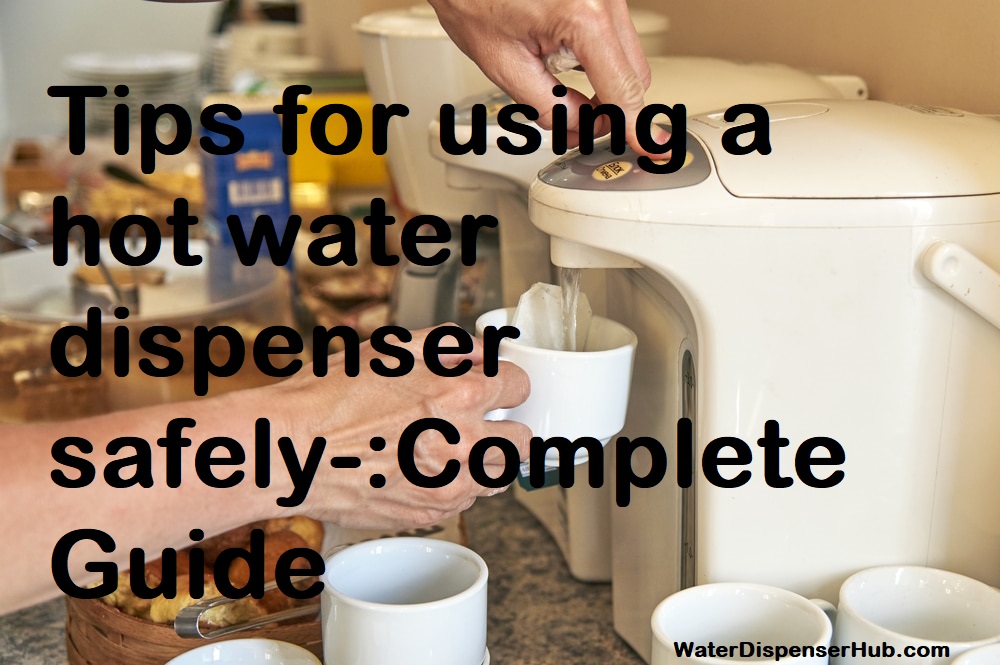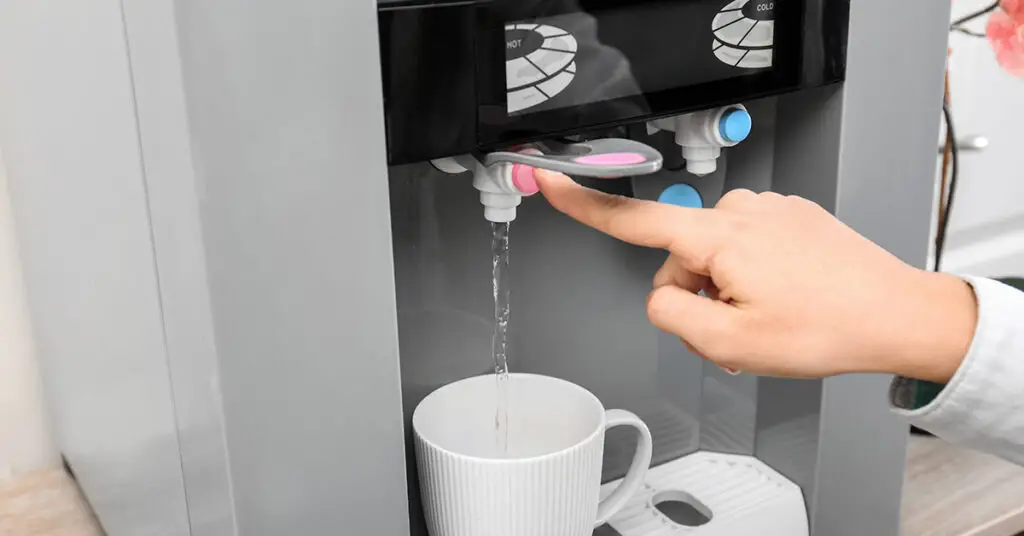Are you considering using a hot water dispenser to make your life easier? If so, it’s important to understand the safety precautions you should take.
With this guide, you’ll learn how to use a hot water dispenser safely – minimizing any risks and ensuring consistent results. You won’t have any trouble at all enjoying the convenience of your new appliance!
Hot water dispensers can be a great addition to any kitchen or office, but there are a few safety precautions you should take when using them. By following the simple steps outlined in this guide, you can ensure maximum convenience and safety when using your hot water dispenser.
The most important thing to remember is that hot water can cause serious burns if not handled properly. Always take care to avoid contact with the hot water as well as steam from its evaporated state, which also carries more concentrated heat and is capable of causing severe burns.
Make sure that any areas around the dispenser have sufficient clearance for ease of use and do your best to keep them free from any potential hazards. Always make sure the unit is securely mounted to avoid it being knocked over by accident or used incorrectly. When filling cups with hot water, keep your hands well back from the outlet point or use a utensil such as a spoon rather than your hands to fill cups safely.
Keep children away from the unit at all times and be wary of clothing made of synthetic materials coming into contact with on-going steam or heated surfaces as these can easily catch fire due to their higher levels of inflamability compared with natural fabrics such as cotton. Make sure that anyone using the unit regularly knows how it works so they know what to expect in terms of temperature and emissions from it at different points throughout use as this will help reduce potential hazards associated with it’s operation.

Explanation of hot water dispensers
A hot water dispenser is a handy kitchen appliance that can provide an immediate source of hot water for cooking, making beverages, and cleaning dishes. In addition to being an efficient time-saver, hot water dispensers are also an energy-saving way to heat water quickly and efficiently. Before using a hot water dispenser, however, it’s important for the user to understand how a hot water dispenser works and important safety tips for its use.
When it comes to types of hot water dispensers, there are both electric and stovetop options. Electric models typically consist of an insulated tank with a tap that dispenses warm or boiling hot water; they usually have adjustable thermostats which allow you to choose your desired heat setting. Stovetop models heat up the same way as any traditional kettle; they are smaller than electric models but can be used wherever there is a gas or electric stovetop burner available
While all safety precautions should be followed when using any piece of kitchen equipment, it is especially important to follow specific directions when dealing with boiling-hot liquids. Below are some tips for safely using and maintaining a hot water dispenser:
1) Always read the manufacturer’s instructions carefully before use – this is especially important when dealing with any electrical appliances; make sure you understand all basic settings on your machine before using it
2) Place the machine away from children so they cannot accidently reach and touch its surface
3) The unit should only be plugged into an appropriate outlet following manufacturer’s instructions
4) Never fill the unit above the maximum fill line indicated by the manufacturer
5) Don’t overly rely on machine settings – check that temperature meets expectations before pouring or consuming liquid from your slow cooker
6) Pour carefully so as not to burn yourself – in some cases potholders may help if handle is too warm
7) Always turn off appliance when not in use
Importance of using hot water dispensers safely
It’s important to be aware of the potential risks associated with using a hot water dispenser. The safety issues are mostly related to prevention of scalding and contact burns due to the extremely hot water that can be dispensed. In addition, the unit must be securely mounted in order to prevent tipping and accidental spilling of hot water.
When using electric models, you should always keep in mind that there is an electrical cord involved. Always follow the manufacturer’s instructions for use and storage, making sure you keep cords clear from any objects that could cause an accident.
Be sure children or those with limited mobility do not have access to hot water at the location where your unit is installed as this could lead to serious injury from burns or scalds. Hot water dispensers should always be used according to their intended usage and not for any other purpose such as boiling or cooking food items.
It is also important that you regularly inspect your hot water dispenser for wear and tear that could lead to leaks or even breakage of interior components due to overuse or incorrect operation. Regular inspections of all electrical components including but not limited to electrical cords, heating elements, standing pipes, restricting devices should also be conducted at least twice a year in order to ensure safe operation at all times.
Choosing a Safe Hot Water Dispenser
Choosing a safe hot water dispenser is one of the most important things you can do to ensure your safety and that of those around you. Hot water dispensers vary in size, cost and features, so make sure that the one you choose is up to various safety standards. Make sure it meets the following criteria:
* The hot water dispenser should have an automatic shutoff feature to prevent overheating or boiling when it runs out of water. An audible alarm and warning lights are also beneficial features.
* Look for a model with an ANSI (American National Standards Institute) listing, UL (Underwriters Laboratories) listing or equivalent certification. This certification means that the product has been tested to meet certain safety standards such as resistance to electricity shock.
* The device should be positioned on a flat and stable surface in order to reduce the risk of tipping over or spilling hot liquids on individuals nearby.
* Check for anti-scalding features like double wall construction and insulated spout covers which help protect from potential burns from touching or using the device.
Types of Hot Water Dispensers
Hot water dispensers provide a faster, more efficient way to access hot water than stovetop or electric kettles. They come in two main types; countertop models and built-in systems. Each type of dispenser has its own advantages and drawbacks.
Countertop models are the more affordable option and can be either freestanding or portable. The great thing about these is that you can move them around if needed and they’re easy to use. Most have a safety shut off function for added protection, but their size may limit the amount of hot water you can access at once.
Built-in hot water dispensers are built into your sink or countertop to free up additional space in your kitchen. Installation usually requires extra plumbing by a professional, so there is an added cost associated with this type of dispenser, but it provides almost immediate access to hot water from the tap with no need for a pot or kettle on the stove top. Built-in systems often feature temperature controls for further safety, but may lack safety shut off switch features as commonly found on countertop units.
Safety Features to Look for
When buying a hot water dispenser, there are a few important safety features that you should keep in mind to ensure risk-free operation. Here is what you should look for when selecting your unit:
- Thermostat – Look for an adjustable thermostat that will allow you to set the temperature of your hot water according to your needs. This prevents the unit from reaching dangerous temperatures, ensuring safer operation and greater user protection.
- Temperature control knob – Like the thermostat, this feature allows you to easily adjust the temperature of the unit, giving you full control over your hot water usage. It’s important that it’s easy to use and clearly labeled so that you know exactly what setting you’re using at any given time.
- Auto shut off switch – If a sudden surge of cold water flows through the unit and causes it to overheat, having an auto shut off switch is essential for preventing any potential dangers associated with overheating. It will detect any abnormal temperatures and immediately cut off power to prevent further damage or injury resulting from prolonged exposure to these high temperatures.
- Safety release valve – Lastly, look for a reliable safety release valve that will prevent pressure buildup in case of an excessive flow of water into your dispenser. It’s an added layer of protection that ensures various hazardous conditions do not develop inside your unit due to improper operation or faulty design.
III. Proper Placement and Installation of Hot Water Dispenser
When you are installing your new hot water dispenser, there are a few important safety guidelines and tips to keep in mind. The location for the installation of the hot water dispenser should be away from any heat source such as stoves, ovens, and heating elements. Placement of the unit is also important; an electrically operated dispenser should be installed in an area where it is not accessible to children.
The hot water dispenser must be properly grounded or installed according to local electrical codes. Electrical outlets should have proper grounding equipment and replaceable fuses or circuit breakers. The wiring and outlet circuits should meet local codes when installing a standard electrical outlet for your hot water dispenser unit. Additionally, do not plug any item other than the approved hot water dispenser into this outlet; such items may cause overload on the socket which can lead to a potential fire hazard, electric shock hazard or catastrophic damage to your device or other items plugged into this same outlet.
Check that your unit has level feet so that it sits securely and doesn’t wobble when used. This keeps all parts from causing unnecessary strain during normal operation of the unit which could lead to serious damage and voiding of your warranty due to misuse or improper maintenance practices by the user. If a wall mount model is selected, ensure that all locks and screws are securely tightened but ensure not use excessive force as strips of forces could cause damage over time leading eventual failure of components inside the device itself.

Location of Hot Water Dispenser
A hot water dispenser should be placed in an area with good ventilation and away from any potential hazards that could cause injury. Choose a spot that is away from direct sunlight and at a height that is easily accessible. Make sure the outlet is within reach of a power source and that the cord or power supply will not be tripped or pulled over when in use.
Finally, place the hot water dispenser on a flat, even surface with enough clearance for safe operation and storage of supplies.
Installation of Hot Water Dispenser
For an effective and safe use of a hot water dispenser, it must be installed by a qualified professional or manufacturer. When handling the installation, emphasis is placed on the need to ensure that safety precautions are observed and necessary steps are taken to avoid potential problems. The following procedure should be considered when installing your hot water dispenser:
- Ensure that your hot water dispenser is placed at a safe height that is out of reach from children as well as physically challenged individuals.
- Make sure the outlet power cord of the device has enough length for convenient maneuverability without being compromised or exposed to any high temperature sources such as steam, water or heaters.
- When possible, try to find or create counter space away from direct sunlight or heat sources because these could overheat your machine and cause malfunctioning.
- Carefully read through the installation instructions provided by the manufacturer while paying attention to any additional safety precautions outlined in these instructions.
- Confirm that all seals and connection points in the machine are properly sealed off and fit tightly. If you have any doubts about this aspect of installation, please do not hesitate to call on a qualified professional for assistance.
Electrical Requirements
When installing and using a hot water dispenser in your kitchen, it is important to understand the electrical requirements to ensure safe operation.
Most hot water dispensers require an AC receptacle rated 120 Volts, DC receptacle rated 18 or 24 volts, or a 3-prong plug and outlet. If your unit uses a DC receptacle, it must be maintained with a current and voltage as specified by the manufacturer and have safety features that protect against thermal overloads and short-circuits.
Additionally, be sure the outlets you use for hot water dispensers are correctly grounded to prevent shocks or electric fires in the event of a power surge. Be sure to read all manufacturer’s instructions before you operate the unit.
Conclusion
It is important that you use your hot water dispenser safely and correctly to prevent unfortunate accidents and prolong the life of your appliance. Even if your hot water dispenser has safety features, it’s still essential to take necessary precautionary measures before, during and after use. Regular cleaning also plays a crucial role in maintaining the quality of your hot water dispenser and keeping yourself safe from potential risks related to its use.
If unforeseen issues arise when using a hot water dispenser, it is best to consult the manual or contact customer service for further help. In addition, if you want to increase efficiency and get even more out of your hot water heater, develop a maintenance routine for it for optimal performance. With all these tips in mind, you should be able to make the most out of this convenient appliance and enjoy its benefits throughout its life span.
FAQ’s
How safe is hot water from a dispenser?
Hot water from a dispenser is generally safe as long as it is kept at the appropriate temperature and maintained properly.
Do you leave a hot water dispenser on all the time?
It depends on the model, but most hot water dispensers are designed to be left on all the time for convenience.
Are hot cold water dispensers safe?
Yes, hot and cold water dispensers are safe as long as they are properly maintained and used according to the manufacturer’s instructions.
Is instant water dispenser safe?
Instant water dispensers are generally safe as long as they are used properly and maintained regularly.
What are the disadvantages of water dispenser?
Some disadvantages of water dispensers include the need for regular maintenance, the cost of electricity or other energy sources, and the risk of contamination if not properly maintained.
Do hot water dispensers use a lot of electricity?
Hot water dispensers can use a significant amount of electricity, but the exact amount will depend on the model and usage.
Is a hot water dispenser better than a microwave?
A hot water dispenser may be more convenient than a microwave for certain tasks, such as making tea or instant soup, but the two appliances serve different purposes and have different benefits.
Does boiling water damage hot water bottle?
Boiling water can damage a hot water bottle if it is not made of appropriate materials or is not designed to handle high temperatures. It is important to follow the manufacturer’s instructions.
How often do you need to clean a hot water dispenser?
Hot water dispensers should be cleaned at least once every three months or as recommended by the manufacturer.
What are the benefits of a hot water dispenser?
Benefits of a hot water dispenser include convenience, energy efficiency, and the ability to quickly heat water to the desired temperature for a variety of purposes.
See more-
- Best water dispenser with ice maker 2023
- Best self cleaning water dispenser 2023
- Best bottom loading water dispenser 2023
- Best instant hot water dispenser 2023
- Best water dispenser with filter 2023

Robert Carlson is the CEO of waterdispenserhub.com and informative website, and a respected author in the dispenser industry. With years of experience and a passion for his work, Robert has become a trusted source of information for consumers and businesses alike. His dedication to excellence and commitment to providing unbiased and independent reviews have earned him a loyal following of readers who trust his expertise and insights. Robert is a true industry expert and a leader in the dispenser industry, and his work has been recognized by his peers and featured in various publications and media outlets.

